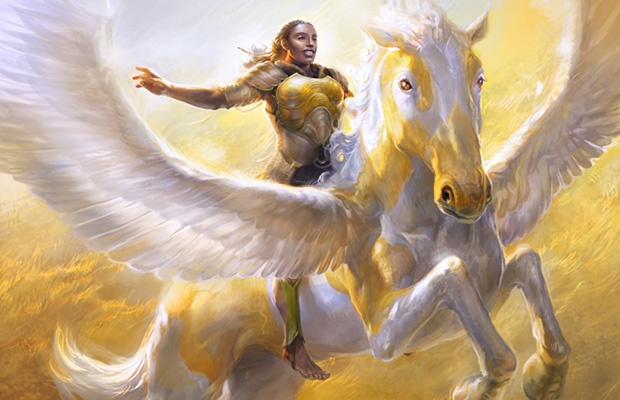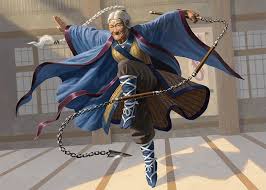Shadows Over Innistrad spoiler season is in full swing. Check out our rolling reviews of the cards. Early reactions to a new set usually focus on constructed. The limited format doesn’t take shape until we see the full spoiler, when we can see the creature landscape that will define the speed and strategies of draft. But we can get some ideas about the format from the mechanics themselves.
Wizards R&D builds limited formats around the mechanics they create. They want to evoke emotion through gameplay, and use mechanics are guides for encouraging that. It is rare that a mechanic is useless in limited, so we can usually assume they built the card set to enable those mechanics to function in forty card decks.
Mechanics are strongest in limited when they reinforce strategies that are already good. When a mechanic pushes you to do things you normally avoid in limited, that is a sign they bent the format to allow that strategy to succeed. For example, the heroic mechanic of Theros encouraged players to put auras in their decks, and the companion mechanic bestow allowed players to play extra auras without reducing the creature count of their decks.
Curving out with creatures, developing a stronger board presence than your opponent, and attacking for damage—this is the fundamental strategy of most limited decks. If you know nothing about the mechanics of a draft format, or a hypothetical format had no mechanics other than evergreen stuff like flying, then you can draft a good curve of creatures and have a solid deck. Creature combat is the backdrop against which all limited mechanics are judged.
Put simply, mechanics that encourage playing and attacking with creatures will be strong in limited, while mechanics that discourage playing and attacking with creatures will be weak. That is the baseline from which you should evaluate new mechanics for limited. It means mechanics like raid, battalion, rally will be easy to incorporate into decks. Spell mastery will be difficult. Some mechanics, like cohort and outlast, encourage playing creatures but not attacking. These will vary in power based on the format, but at least interact on the central axis of limited games.
When a mechanic does not interact with combat, it has to bring something else to the table to justify a slot in your deck. If it goes on individually powerful cards without requiring you alter your deck to use it, like delve, then there’s no problem. But many mechanics like this push you to include more non-creature spells, which hurts the basic creature combat strategy.
The average limited deck plays about 17 creatures and 17 lands. This means you only have six other slots for all other card types. A mechanic like spell mastery from Magic Origins requires you to play many instants and sorceries to get the full effect of your spells. Even if you fit eight of these cards in your deck, it will still be hard to have two of them in your graveyard when you resolve a third one that has spell mastery. And thus the mechanic rarely proved useful in limited.
When Wizards R&D wants you to play with one of these divergent mechanics, they build the format to enable putting the right non-creature, non-land spells in your deck. Heroic in Theros demanded many combat tricks and auras. To make room, they included the bestow mechanic so you could play an aura and a creature in one slot of your deck. This helped make heroic a strong mechanic despite working against normal limited deckbuilding strategy.
Prowess in Khans of Tarkir also had this issue. You could only fit maybe 13 creature cards in a Jeskai prowess deck because of all the other cards you needed to reliably trigger prowess. Spells that make creature tokens, like Hordeling Outburst, Take Up Arms, Soul Summons, and Write Into Being helped bridge the deckbuilding gap. Note also that both heroic and prowess make your creatures better in combat, so despite requiring dedicating deck slots to other card types, you still interact on the important creature combat axis. If doing all this work doesn’t help with creature combat, it usually isn’t worth the effort.
So what does this tell us about the mechanics of Shadows Over Innistrad? Let’s take a look:
Transform (double-faced cards)
These cards are mostly creatures, or they transform into creatures. They should fit right into your decks without trouble. Most double-faced cards are quite powerful, but many require staying on board for multiple turns to provide full value.
Madness
Madness requires discard outlets, but otherwise fits easily. It tends to appear on creatures and removal spells, which you want to play anyway. If you pick up a few discard enablers, madness will be good in your deck.
Skulk
Evasion mechanics are always good in limited. Skulk requires small creatures to be effective, which means it will push you to play a longer, controlling game while you peck away each turn. It should be good.
Investigate/Clue Tokens
There are various ways to create clue tokens through the investigate mechanic. Mostly, these seem to trigge roff things you want to do anyway—cast a spell, play a land, deal combat damage. The clue tokens are artifacts that you can sacrifice for two mana to draw a card. This is a slow mechanic that provides momentum in the late game. Assuming you are playing investigate cards that are otherwise creatures or good spells, it will fit your general strategy. Enchantments that interact with investigate, like Trail of Evidence, will be harder to use effectively.
Delirium
Here’s the big one. Delirium provides upside to cards when you have four or more different card types in your graveyard. Your alarm bells should be going off. If 34 of the cards in your limited deck are creatures or lands, how will you get two more card types into your graveyard to turn on delirium? Wizards has to do some serious work to make this mechanic relevant in limited.
Fortunately, I think they did. Land sacrificing looks like a minor theme, and incidental self-mill will toss some lands into your graveyard as well. Madness means there are discard outlets that let you toss a needed card type to the bin. And they have printed a few enchantments that you can sacrifice, like Sinister Concoction, which also helps get a couple more cards in your graveyard when you use it. Many of the delirium cards look incredible if you can turn them on. Topplegeist is my favorite but they all look solid. Whether the tools are there to build a reliable delirium deck without ruining your basic strategy remains to be seen, but it seems likely to work. Note that Delirium also pushes games to go longer, as your graveyard will fill up as the game progresses even if you don’t go out of your way to speed up the process.
Milling
It isn’t a named mechanic, but Shadows Over Innistrad includes a lot of cards that “mill” your opponent by putting cards from atop their library into their graveyard. Manic Scribe is a good example. Running your opponent out of cards to draw is an alternate win condition that does not interact with creature combat. Usually it is not a good strategy in limited. While decks only have forty cards (unless they sideboard in more to defend against being decked), games have to go long or the milling cards have to be very good to make the strategy viable. The other mechanics tend to push toward longer games, so maybe it will work. But delirium encourages players to fill their graveyards, meaning aggressive milling might backfire on you.
Conclusion
It looks like Shadows Over Innistrad will be a slower limited format. Madness enables huge tempo swings, which can lead to fast wins, but investigate, transform, delirium, skulk, and milling all favor long games. Milling will probably be too risky to be a common strategy, but clue tokens will probably be good and delirium has a solid chance of working despite the weird card types you’ll need to play. I am excited to revisit Innistrad and see if they captured the magic of that plane in another sweet limited format.
Carrie O’Hara is Editor-in-Chief of Hipsters of the Coast.




